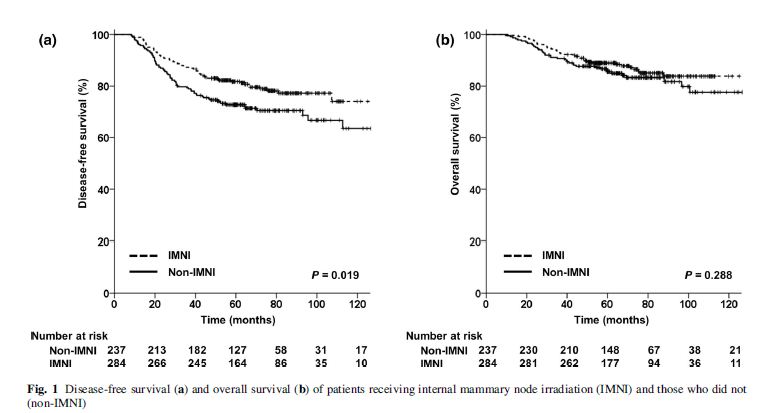글로벌 연구동향
방사선종양학
- Does internal mammary node irradiation affect treatment outcome in clinical stage II-III breast cancer patients receiving neoadjuv ant chemotherapy?
연세의대/ 김경환, 서창옥*
- 출처
- Breast Cancer Res Treat
- 등재일
- 2015 Aug
- 저널이슈번호
- 152(3):589-99
- 내용

[Abstract]The purpose of this study is to assess the value of internal mammary node irradiation (IMNI) in patients receiving postoperative radiotherapy after neoadjuvant chemotherapy (NAC) using modern systemic therapy. Between 2001 and 2009, 521 consecutive patients with clinical stage II-III breast cancer received NAC and postoperative radiotherapy. With a consistent policy, the treating radiation oncologist either included (N = 284) or excluded (N = 237) the internal mammary node in the treatment volume. Anthracycline- and taxane-based chemotherapy was provided to 482 (92.5 %) patients. To account for the unbalanced characteristics between the two groups, we performed propensity score matching and covariate adjustment using the propensity score. The median follow-up duration was 71 months (range 31-153 months). The 5-year disease-free survival (DFS) with and without IMNI was 81.8 and 72.7 %, respectively (p = 0.019). The benefit of IMNI varied according to patient characteristics such that it was more apparent in patients with N1-2 disease, inner/central location, and triple-negative subtype. After adjusting for all potential confounding variables, IMNI was independently associated with improved DFS (p = 0.049). The significant effect of IMNI on DFS was sustained after propensity score matching (p = 0.040) and covariate adjustment using the propensity score (p = 0.048). Symptomatic radiation pneumonitis developed in 9 (3.2 %) patients receiving IMNI. Our results indicated that IMNI was associated with a significant improvement in DFS with low toxicity rate for breast cancer patients receiving NAC. Further prospective studies are warranted to confirm the effect of IMNI in the NAC setting.
[Author information]
Kim KH1, Noh JM, Kim YB, Chang JS, Keum KC, Huh SJ, Choi DH, Park W, Suh CO.
1Department of Radiation Oncology, Yonsei Cancer Center, Yonsei University College of Medicine, 50 Yonsei-ro, Seodaemun-gu, Seoul, 120-752, Republic of Korea.
- 연구소개
- 유방암에서 수술 후 방사선치료를 할 때 내유림프절(internal mammary lymph nodes)를 포함하여야 하는 문제는 오랫 동안 controvertial issue가 되어 왔다. 유방암이 내유림프절로 전이될 확률은 상당히 높지만 임실히 임상적으로 생존율 향상에 대한 근거도 부족하고 내유림프절치료에 따르는 부작용 발생 확률도 높아질 것이라는 우려 때문에 확실한 guideline이 없는 상태에서 치료하는 방사선종양학 의사의 결정에 때라 내유림프절 치료 여부가 시행되어져 왔다. 저자들은 연세대 세브란스병원과 삼성서울병원의 환자396명을 대상으로 유방전절제술 후 방사선치료를 할 때 내유림프절 포함 여부가 무병생존율에 영향을 줌을 보고한 바 있다(Chang JS, Park W, Kim YB, Lee IJ, Keum KC, Lee CG, Choi DH, Suh CO, Hur SJ. Long-term survival outcomes following internal mammary node irradiation in stage II-III breast cancers: results of a larger retrospective study with 12-year follow-up. Int J Radiat Oncol Biol Phys 2013;28(5):867-72.) 이번 연구는 위 논문의 후속 연구로 근래 많이 시행되고 있는 선행화학요법 후 시행한 방사선치료에서도 같은 결과를 보이는 지를 알아본 연구이다. 이번 연구에서는 전절제술 환자 뿐만 아니라 유방보존술을 시행한 환자들도 포함하여 521명을 뷴석하였는데 선행화학요법을 하지 않은 환자들과 마찬가지로 내유림프절을 치료한 환자들의 무병생존율이 더 높았다, 특히 N1-2 환자들, 내측 유방암, 삼중음성 유방암(triple-negative breast cancer)환자들에서 무병생존율 향상 효과가 더 뚜렷했다. 최근 내유림프절이 생존율을 증가시킨다는 EORTC 연구가 발표되었지만 아직 consensus를 이루지는 못하고 있는 상태에서 내유림프절 치료를 옹호하는 연구 결과이다. 후향적 연구라는 단점이 있으나 선행화학요법 후 시행한 방사선치료 환자들에서 내유림프절 치료 효과를 본 연구로는 세계적으로 처음이어서 실제 진료에 매우 유용한 정보라고 생각된다.
- 덧글달기









